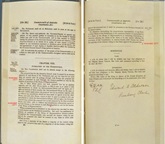|
1975
|
Joint Standing Committee on the New Parliament House
|
|
| |
Parliament establishes a Joint Standing Committee on the New and Permanent Parliament House as the client for the planning, design and construction of the building. [1]
The Committee produces a number of reports and recommends that the designer be selected through an open two-stage architectural competition. It also endorses a timetable to complete the first stage of approximately 51 100 square metres of usable area by 26 January 1988, and the second stage to be completed sometime after the year 2000. During development of the competition brief, the Committee acknowledges that the construction may be undertaken in one major stage, and requests an overall master plan to guide future expansion. [2]
|
|
| 1977 |
The right to vote in referenda |
|
| |
On 21 May 1977 residents of the Northern Territory and the Australian Capital Territory are given the right to vote in constitutional elections following a successful referendum to amend section 128 of the Constitution. The question gains a YES vote in every state. |

Constitution Alteration (Referendums) Act 1977 (No. 84 of 1977)
Image courtesy of National Archives of Australia
|
|
1977
|
Canberra exhibition
|
|
| |
The National Capital Development Commission stages an exhibition to illustrate how Canberra will be developed.
It includes impressions of a hypothetical scheme for Parliament House on Capital Hill prepared by Canberra architect, Bert Read. The scheme is on public display for several weeks, and appears in published reports from the Joint Standing Committee on the New and Permanent Parliament House. [3]
|
|
|
1978
|
A permanent Parliament House
|
|
| |
On 22 November 1978 Prime Minister the Rt Hon. Malcolm Fraser (LP, Member for Wannon, Vic., 1955‒83) announces that the building of a new Parliament House will proceed, to be completed by Australia Day 1988 in the bicentennial year of European settlement, at an estimated cost of $151 million. [4]
|
|